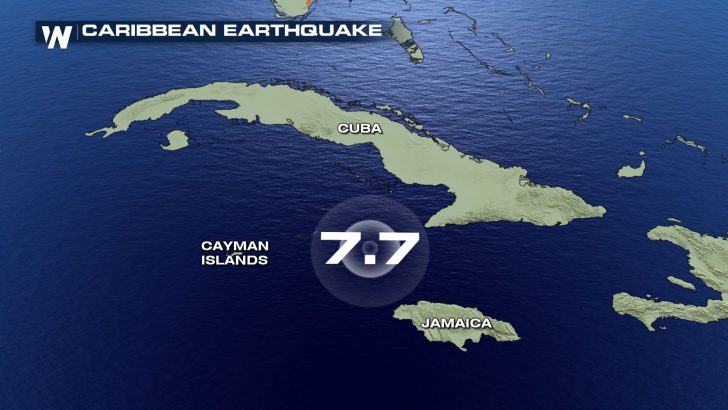7.6 Earthquake Near Cayman Islands Triggers Tsunami Warnings
A powerful magnitude-7.6 earthquake struck the Caribbean Sea southwest of the Cayman Islands on Saturday evening, causing widespread concern across the region and triggering tsunami alerts in several nations. The earthquake, which occurred at 6:23 p.m. local time, had a depth of 10 kilometers (6.2 miles) and was located approximately 130 miles (209 kilometers) south-southwest of George Town, the capital of the Cayman Islands. The quake’s intensity was felt across nearby regions, prompting immediate action from local authorities to protect residents.
In response to the earthquake, the U.S. National Tsunami Warning Center initially issued a tsunami advisory for Puerto Rico and the U.S. Virgin Islands. However, this advisory was later canceled, with no tsunami alert being issued for the U.S. mainland. The early warning caused significant concern in Puerto Rico, where alarms in the northwest region led people to evacuate coastal areas. This mass movement of residents created heavy traffic, according to local media outlets, as people hurried inland to safety. Governor Jenniffer González Colón of Puerto Rico assured the public that she was in close contact with emergency agencies, but did not recommend evacuations from the coast at that time. While the threat of a tsunami had subsided, authorities continued to monitor the situation carefully.
Other Caribbean nations also responded quickly to the seismic activity. The Dominican government issued a tsunami alert for its coastal areas and recommended that residents move to higher ground—specifically to areas at least 20 meters (66 feet) above sea level and 2 kilometers inland. This precautionary measure was taken due to the risk of potential tsunami waves, but the alert was later canceled after further assessments confirmed that the threat had passed. Similarly, the Cuban government called on citizens to leave beachfront areas as a precautionary measure. The Bahamas Department of Meteorology also issued a tsunami advisory for its residents, urging them to remain vigilant and prepared in case of any sudden changes in the situation.
Honduran authorities, meanwhile, reported that there were no immediate reports of damage from the earthquake but urged people to stay away from beaches as a safety measure. In addition, the U.S. National Oceanic and Atmospheric Administration (NOAA) released an updated statement indicating that tsunami waves of 1 to 3 meters (3.3 to 9.8 feet) above the tide level were possible along some coasts of Cuba. NOAA emphasized, however, that actual wave heights at the coast may vary due to uncertainties in the forecast and local geographical features. The agency cautioned that the situation could evolve, and further monitoring was necessary.
In the Cayman Islands, local authorities were quick to respond to the earthquake. Hazard Management Cayman Islands urged residents who live near the coastline to move inland and seek higher ground as a precautionary measure. The agency indicated that wave heights of 0.3 to 1 meter (1 to 3 feet) were expected, but no significant tsunami or damage had been reported as of Saturday evening. The local authorities also made it clear that the situation remained under active monitoring, and residents were advised to stay alert for any potential aftershocks or changes in the threat level. While the earthquake’s epicenter was located far out in the sea, the risk of a tsunami remained a concern for several hours following the tremor.
While no fatalities or significant injuries have been reported from the earthquake, the event served as a reminder of the seismic risks present in the Caribbean region, which is prone to earthquakes and tsunamis. In addition to the immediate impact, authorities are closely monitoring the area for aftershocks, which can often follow large earthquakes. There have been no reports of major damage to infrastructure or buildings, but authorities continue to encourage residents to be cautious and stay informed through official channels.
As of now, residents in the affected areas are advised to stay alert, follow official guidance from local authorities, and remain prepared for any further developments. Emergency teams remain on standby to assist with any needs in the aftermath, and authorities are maintaining a vigilant watch for possible aftershocks or changes in the tsunami threat. It’s important for people in the region to stay informed and ready to act quickly if necessary as the situation evolves.
The Cancer-Fighting Diet: Foods You Need to Know About | Maya




